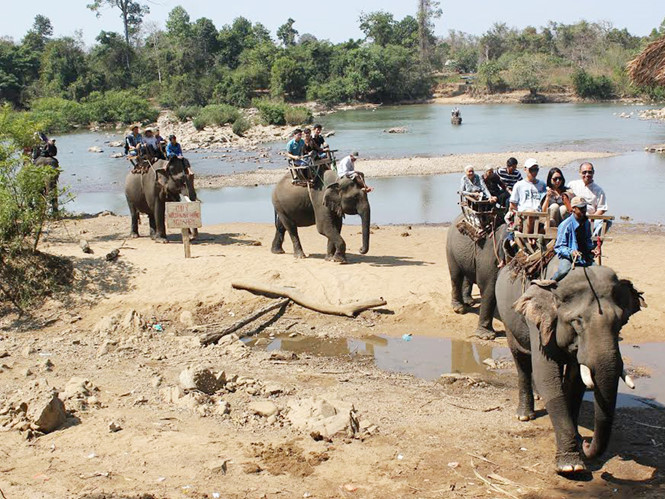Experts were divided over a draft plan to begin elephant-watching tours in the central province of Quang Nam when they met last week at the launch of the 1st Elephant Conservation Week.
The plan by the Forestry Administration, is to launch a tour in Quang Nam’s Nong Son District in the first stage.
Conservationists estimated six to 10 wild elephants live in a forest of nearly 17,500 hectares (43,240 acres) in the district. A herd of around six was seen by some locals last month.
“It is too early to say that the plan is too risky” Cao Chi Cong, deputy director of the administration, said.
The Forest Planning and Investigation Department would study the elephant numbers and their habitats in Nong Son for better conservation and promoting tourism, he said.
The number of wild elephants in Vietnam has fallen from 2,000 in the 1980s to around 100 now in 15 forests, including in Nong Son.
However, some experts were skeptical about the plan’s feasibility and effectiveness, especially since there have been frequent cases of elephant-human clashes.
Phan Tuan, director of the Quang Nam Forest Protection Agency, said he is afraid the wild elephants in the province are too dangerous.
“Le Quang Kim, former head of the Que Son District Forest Protection Agency, is living with partial paralysis in his lower body after he was attacked by wild elephants and broke his backbone in 2003.”
Nguyen Vu Linh, deputy director of the Nature Conservation Department, said the elephants in Quang Nam have become aggressive due to habitat loss.
“An area of 17,500 hectares is not enough for the herd.”
Ho Tan Cuong, deputy director of the Quang Nam Culture, Sports and Tourism Department, said it would be difficult for tourists to spot the elephants.
“Elephants are afraid of humans. What if tourists cannot see them?”
Proper design needed
But Cong insisted that the tourism plan is feasible since there would be cameras in the forest to track the animals.
“Theoretically, elephant watching tours will not be risky because there will be many measures, like establishing a safe corridor and strict regulations for tourists.”
Relevant agencies would also establish a buffer zone of five to 10 kilometers, he added.
Richard Thomas of wildlife trade monitoring network TRAFFIC said the Asian elephant population in Vietnam is small and particularly at risk.
“If properly designed and implemented, ecotourism can certainly play an important role in helping raise awareness of the plight of particular species and the need for conservation action,” he told Thanh Nien News.
“Of course it’s key to make sure it is implemented in a manner that does not negatively impact on the species it has been designed to assist.”
|
1st VIETNAM ELEPHANT CONSERVATION WEEK
|
|
The 1st Elephant Conservation Week was held in Quang Nam from August 3 to 6. It was organized under the “Emergency Elephant Conservation and Capacity Building to Control Ivory Trade in Vietnam till 2020” project, funded and implemented by the Vietnamese government.
The week included many activities, including a mini marathon (5km) – “Run for Vietnam’s Elephants” – to raise awareness about elephant conservation and engage the local community in support of establishing elephant protection zones in Quang Nam Province.
The run was supported by the U.S. Agency for International Development- funded Asia’s Regional Response to Endangered Species Trafficking (ARREST) program, implemented by Freeland.
The other activities included a meeting between the Vietnam Forest Administration, local authorities and tour operators to discuss how to develop elephant-friendly ecotourism, and working with local communities to prevent human-elephant conflict.
A roundtable meeting was held between the administration, the Center of Dak Lak Elephant Conservation and Quang Nam Province to discuss elephant conservation methods in the country.
|
